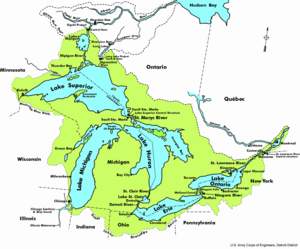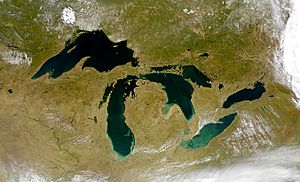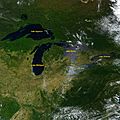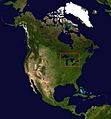Great Lakes facts for kids
Quick facts for kids Great Lakes of North America |
|
|---|---|
| Great Lakes | |

The Great Lakes seen from NASA's Aqua satellite in August 2010. From left to right: Lake Superior, Michigan, Huron, Erie, Ontario
|
|
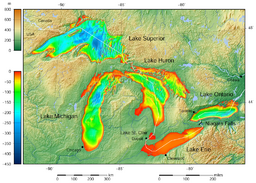
Bathymetry map of the Great Lakes
|
|
| Location | Eastern North America |
| Coordinates | 45°N 84°W / 45°N 84°W |
| Type | group of interconnected freshwater lakes |
| Part of | Great Lakes Basin |
| Primary inflows | Past: precipitation and meltwater Now: rivers, precipitation, and groundwater springs |
| Primary outflows | Evaporation, St. Lawrence River to the Atlantic Ocean |
| Basin countries | Canada, United States |
| Surface area | 94,250 square miles (244,106 km2) |
| Average depth | 60–480 ft (18–146 m) depending on the lakes |
| Max. depth | 210–1,300 ft (64–396 m) depending on the lakes |
| Water volume | 5,439 cubic miles (22,671 km3) (lowest) |
| Frozen | around January to March |
The Great Lakes are five huge lakes located in east-central North America. They hold about 21% of the world's fresh water found on the surface. That's a lot of water!
The five lakes are:
Contents
How Were the Great Lakes Formed?
A very long time ago, during the Ice Age, giant sheets of ice called glaciers covered much of North America. These glaciers acted like huge bulldozers. They scraped and carved the land as they slowly moved.
About 10,000 years ago, the climate started to get warmer. The glaciers began to melt. The melting ice filled the deep basins that the glaciers had carved. This is how the Great Lakes we see today were created.
Where Are the Great Lakes Located?
Four of the Great Lakes are on the border between Canada and the United States. Only Lake Michigan is completely inside the United States.
Together, these lakes hold the most fresh water of any lake group in the world. However, no single Great Lake is larger than Lake Baikal in Russia or Lake Tanganyika in East Africa.
Many big cities are located near the Great Lakes or their connecting rivers. These include Chicago, Illinois (on Lake Michigan), Toronto, Ontario (on Lake Ontario), and Detroit, Michigan (on the Detroit River).
How Are the Great Lakes Connected?
Even though the five lakes have their own areas, they all connect to form one large body of freshwater. This connection links the middle of North America to the Atlantic Ocean.
Lakes Michigan, Huron, and Erie are at similar heights. Ships can easily travel between them. Water flows from Lake Superior and Lake Michigan into Lake Huron. Then it goes through the Detroit River into Lake Erie. From there, it flows over Niagara Falls into Lake Ontario. Finally, it travels through the St. Lawrence River to the Atlantic Ocean.
Many rivers flow into the lakes from a large area called a watershed. The Great Lakes also have about 35,000 islands! The region includes these five big lakes and thousands of smaller ones.
| Lake Erie | Lake Huron | Lake Michigan | Lake Ontario | Lake Superior | |
|---|---|---|---|---|---|
| Surface area | 25,700 km2 (9,910 sq mi) | 60,000 km2 (23,000 sq mi) | 58,000 km2 (22,300 sq mi) | 19,000 km2 (7,340 sq mi) | 82,000 km2 (31,700 sq mi) |
| Water volume | 480 km3 (116 cu mi) | 3,500 km3 (850 cu mi) | 4,900 km3 (1,180 cu mi) | 1,640 km3 (393 cu mi) | 12,000 km3 (2,900 cu mi) |
| Elevation | 174 m (571 ft) | 176 m (577 ft) | 176 m (577 ft) | 75 m (246 ft) | 182.9 m (600.0 ft) |
| Average depth | 19 m (62 ft) | 59 m (195 ft) | 85 m (279 ft) | 86 m (283 ft) | 147 m (483 ft) |
| Maximum depth | 64 m (210 ft) | 228 m (748 ft) | 282 m (925 ft) | 245 m (804 ft) | 406 m (1,333 ft) |
What Are Seiches?
The unique shape of the Great Lakes can cause large waves called seiches. Imagine a strong storm causing air pressure to quickly increase on one side of a lake. This pushes the water level down on that side. Then, the water rushes up on the opposite side, creating a sudden, tall wave. For example, a 10-foot wave in Chicago caused several deaths in 1954.
What Threats Do the Great Lakes Face?
The Great Lakes are home to many kinds of fish and other living things. However, they face some serious threats.
Invasive Species in the Great Lakes
Invasive species are plants or animals that are not native to an area. They can cause big problems when they are accidentally brought into a new place. Since the 1800s, about 160 different species have invaded the Great Lakes. They cause harm to the environment and the economy.
These invaders can take food away from native fish. They can also cause harmful algae blooms. Some even clog pipes for water systems. On average, a new invasive species enters the Great Lakes every eight months.
Two major invaders are the zebra mussel (found in 1988) and the quagga mussel (found in 1989). These tiny molluscs are very good at filtering water. They compete with native mussels for food. They also reduce food and places for fish to lay their eggs.
These mussels also cause problems for industries. They can block pipes that carry water for factories. Experts believe the zebra mussel could cost about $5 billion over ten years. Quagga mussels make the lake water clearer by filtering out tiny plants. This allows more sunlight to reach deeper, which can increase algae growth.
Pollution in the Great Lakes
Chemicals from factories can flow into rivers and then into the lakes. Some of these chemicals, like mercury, are very toxic. Also, dirty water from sewer overflows can reach the lakes. This can lead to beaches being closed because of harmful bacteria.
Why Are the Great Lakes Important?
The Great Lakes are super important for many reasons:
- Drinking water: They provide drinking water for millions of people in both the United States and Canada.
- Transportation: The Great Lakes are like giant highways for ships. They allow ships to transport goods like iron ore, grain, and coal to different cities and countries.
- Fishing: The Great Lakes are home to many different kinds of fish, like trout, salmon, and whitefish. People fish in the Great Lakes for fun and for food.
- Recreation: The Great Lakes are a great place to have fun! People go swimming, boating, kayaking, and sailing on the lakes. There are also beautiful beaches and parks along the shores of the Great Lakes.
- Ecosystem: The Great Lakes are home to a wide variety of plants and animals. They provide a habitat for fish, birds, mammals, and insects.
Fun Facts About the Great Lakes
- Lake Superior is the largest freshwater lake in the world by surface area. That means it covers the most space!
- The water in Lake Superior is so clear that you can see objects up to 27 feet (8 meters) deep!
- Lake Michigan is the only Great Lake that is entirely within the United States.
- Lake Huron has the longest shoreline of all the Great Lakes, including about 30,000 islands!
- Lake Erie is the shallowest of the Great Lakes, with an average depth of only 62 feet (19 meters).
- Lake Ontario is the smallest of the Great Lakes by surface area. It's connected to the Atlantic Ocean by the St. Lawrence Seaway, which allows ships to travel from the Great Lakes to the ocean.
Images for kids
-
Terra MODIS image of the Great Lakes, January 27, 2005, showing ice beginning to build up around the shores of each of the lakes, with snow on the ground; Green Bay, the North Channel, Saginaw Bay, and Lake St. Clair show complete ice coverage.
-
Chicago on Lake Michigan is in the western part of the lakes megalopolis and the site of the waterway linking the lakes to the Mississippi River valley
-
Detroit on the Detroit River links the region's central metropolitan areas
-
South Bass Island in Lake Erie
-
Toronto on Lake Ontario is in the eastern section of the Great Lakes Megalopolis
-
Map of Glacial Lake Algonquin and its Correlatives (USGS 1915)
-
Lake sturgeon, the largest native fish in the Great Lakes and the subject of extensive commercial fishing in the 19th and 20th centuries is listed as a threatened species
-
Cliffs at Palisade Head on Lake Superior in Minnesota near Silver Bay.
-
The passenger ship SS Eastland (foreground) leaving Chicago, c. 1909
-
Photograph of Lakes Ontario, Erie and Huron plus the Finger Lakes of upstate New York, June 14, 2012, taken aboard the International Space Station, with lake names added
-
Escanaba's Ludington Park in Michigan
See also
 In Spanish: Grandes Lagos (América del Norte) para niños
In Spanish: Grandes Lagos (América del Norte) para niños


